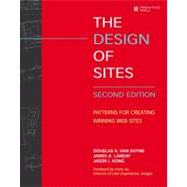
Note: Supplemental materials are not guaranteed with Rental or Used book purchases.
Purchase Benefits
What is included with this book?
| Foreword | p. xxix |
| Preface | p. xxxiii |
| Acknowledgments | p. xli |
| Foundations of Web Site Design | p. 1 |
| Customer-Centered Web Design: More Than a Good Idea | p. 31 |
| The Evolution of Web Design | p. 3 |
| The Importance of Customer-Centered Design | p. 6 |
| Our First Steps toward Unifying Design, Usability, and Marketing | p. 8 |
| Why We Prefer Customer-Centered Design | p. 9 |
| Nine Myths of Customer-Centered Design | p. 12 |
| Applying Customer-Centered Design | p. 15 |
| Take-away Ideas | p. 16 |
| Making the Most of Web Design Patterns | p. 19 |
| What Are Patterns? | p. 19 |
| A Sample Pattern | p. 20 |
| How to Read a Pattern | p. 23 |
| How Much Do Patterns Change Over Time? | p. 25 |
| How to Use the Patterns | p. 30 |
| An Example of Using Patterns | p. 31 |
| Take-away Ideas | p. 37 |
| Knowing Your Customers: Principles and Techniques | p. 39 |
| Principles for Knowing Your Customers | p. 40 |
| Techniques for Knowing Your Customers | p. 50 |
| Take-away Ideas | p. 67 |
| Involving Customers with Iterative Design | p. 694 |
| The Iterative Design Process | p. 69 |
| Reasons to Use Iterative Design | p. 71 |
| Designing with Goals and Principles in Mind | p. 73 |
| Rapid Prototyping | p. 80 |
| Evaluating Your Web Site | p. 90 |
| Take-away Ideas | p. 95 |
| Processes for Developing Customer-Centered Sites | p. 5 |
| Development Process Overview | p. 98 |
| The Discovery Phase | p. 100 |
| The Exploration Phase | p. 105 |
| The Refinement Phase | p. 106 |
| The Production Phase | p. 108 |
| The Implementation Phase | p. 110 |
| The Launch Phase | p. 113 |
| The Maintenance Phase | p. 113 |
| Take-away Ideas | p. 115 |
| Patterns | p. 117 |
| Pattern Group A: Site Genres 119 | |
| Personal E-Commerce | p. 120 |
| News Mosaics | p. 128 |
| Community Conference | p. 136 |
| Self-Service Government | p. 148 |
| Nonprofits as Networks of Help | p. 154 |
| Grassroots Information Sites | p. 161 |
| Valuable Company Sites | p. 167 |
| Educational Forums | p. 174 |
| Stimulating Arts and Entertainment | p. 182 |
| Web Apps That Work | p. 187 |
| Enabling Intranets | p. 195 |
| blogs | p. 201 |
| Pattern Group B: Creating a Navigation Framework | p. 215 |
| Multiple Ways to Navigate | p. 216 |
| Browsable Content | p. 221 |
| Hierarchical Organization | p. 226 |
| Task-Based Organization | p. 231 |
| Alphabetical Organization | p. 235 |
| Chronological Organization | p. 238 |
| Popularity-Based Organization | p. 241 |
| Category Pages | p. 247 |
| Site Accessibility | p. 251 |
| Pattern Group C: Creating a Powerful Homepage | p. 267 |
| Homepage Portal | p. 268 |
| Up-Front Value Proposition | p. 277 |
| Pattern Group D: Writing and Managing Content | p. 283 |
| Page Templates | p. 284 |
| Content Modules | p. 291 |
| Headlines and Blurbs | p. 297 |
| Personalized Content | p. 303 |
| Message Boards | p. 314 |
| Writing for Search Engines | p. 324 |
| Inverted-Pyramid Writing Style | p. 332 |
| Printable Pages | p. 339 |
| Distinctive HTML Titles | p. 343 |
| Internationalized and Localized Content | p. 349 |
| Style Sheets | p. 356 |
| Pattern Group E: Building Trust and Credibility | p. 365 |
| Site Branding | p. 366 |
| E-Mail Subscriptions | p. 372 |
| Fair Information Practices | p. 378 |
| Privacy Policy | p. 384 |
| About Us | p. 391 |
| Secure Connections | p. 398 |
| E-Mail Notifications | p. 402 |
| Privacy Preferences | p. 410 |
| Preventing Phishing Scams | p. 418 |
| Pattern Group F: Basic E-Commerce | p. 431 |
| Quick-Flow Checkout | p. 432 |
| Clean Product Details | p. 439 |
| Shopping Cart | p. 449 |
| Quick Address Selection | p. 458 |
| Quick Shipping Method Selection | p. 464 |
| Payment Method | p. 469 |
| Order Summary | p. 475 |
| Order Confirmation and Thank-You | p. 480 |
| Easy Returns | p. 485 |
| Pattern Group G: Advanced E-Commerce | p. 491 |
| Featured Products | p. 492 |
| Cross-Selling and Up-Selling | p. 500 |
| Personalized Recommendations | p. 510 |
| Table of Contents provided by Publisher. All Rights Reserved. |
The New copy of this book will include any supplemental materials advertised. Please check the title of the book to determine if it should include any access cards, study guides, lab manuals, CDs, etc.
The Used, Rental and eBook copies of this book are not guaranteed to include any supplemental materials. Typically, only the book itself is included. This is true even if the title states it includes any access cards, study guides, lab manuals, CDs, etc.